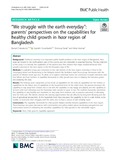| dc.contributor.author | Chakraborty, Barnali | |
| dc.contributor.author | Yousefzadeh, Sepideh | |
| dc.contributor.author | Darak, Shrinivas | |
| dc.contributor.author | Haisma, Hinke | |
| dc.date.accessioned | 2022-04-24T05:15:46Z | |
| dc.date.available | 2022-04-24T05:15:46Z | |
| dc.date.copyright | 2020 | |
| dc.date.issued | 2020-01-31 | |
| dc.identifier.citation | Chakraborty, B., Yousefzadeh, S., Darak, S., & Haisma, H. (2020). "We struggle with the earth everyday": Parents' perspectives on the capabilities for healthy child growth in haor region of Bangladesh. BMC Public Health, 20(1) doi:10.1186/s12889-020-8196-9 | en_US |
| dc.identifier.uri | http://hdl.handle.net/10361/16560 | |
| dc.description | This article was published in BMC Public Health [ © The Author(s). 2020 Open Access This article is distributed under the terms of the Creative Commons Attribution 4.0 International License (http://creativecommons.org/licenses/by/4.0/).] and the definite version is available at: https://doi.org/10.1186/s12889-020-8196-9 The Journal's website is at: https://link.springer.com/article/10.1186/s12889-020-8196-9 | en_US |
| dc.description.abstract | Background: Childhood stunting is an important public health problem in the haor region of Bangladesh. Haor
areas are located in the north-eastern part of the country and are vulnerable to seasonal flooding. The key objective
of this study is to identify the capabilities of the parents and their children that shape multidimensional child
growth outcomes in the haor region in the first thousand days of life.
Methods: A qualitative study was conducted in two sub-districts of the haor region, including in Derai in the
Sunamganj district and Baniachang in the Habiganj district. We facilitated eight focus group discussions with the
parents of children under age two. To allow us to explore individual stories, we conducted in-depth interviews with
four fathers and four mothers. A capability framework to child growth was used in shaping the interview guides
and analysing the data.
Results: The findings were categorised at four levels: a) capabilities for the child, b) capabilities for the mother, c)
capabilities for the father, and d) capabilities at the household level. At the child’s level, the parents discussed the
capability to stay away from disease and to eat well, the capability to stay happy and playful, and the capability to
be born with God’s blessings and the hereditary traits needed to grow in size. The mothers frequently mentioned
the capability to stay healthy and nourished, to stay away from violence, and to practice autonomy in allocating
time for child care. The fathers stressed the earning opportunities that are affected by long-term flooding and the
loss of agricultural productivity. At the household level, they discussed the capability to live in a safe shelter, to be
mobile, to overcome their struggles with the earth, and to have a source of safe drinking water.
Conclusions: The capability framework for child growth helped identify relevant capabilities in the haor region.
These findings can guide discussions with communities and policy makers about developing programmes and
interventions aimed at enhancing the identified capabilities for child growth in this vulnerable region. | en_US |
| dc.language.iso | en_US | en_US |
| dc.publisher | Springer Link | en_US |
| dc.relation.uri | https://link.springer.com/article/10.1186/s12889-020-8196-9 | |
| dc.subject | Haor | en_US |
| dc.subject | Child growth | en_US |
| dc.subject | Capability approach | en_US |
| dc.title | “We struggle with the earth everyday”: parents’ perspectives on the capabilities for healthy child growth in haor region of Bangladesh | en_US |
| dc.type | Journal Article | en_US |
| dc.description.version | Published | |
| dc.contributor.department | Brac James P. Grant School of Public Health | |
| dc.identifier.doi | https://doi.org/10.1186/s12889-020-8196-9 | |
| dc.relation.journal | BMC Public Health | |

